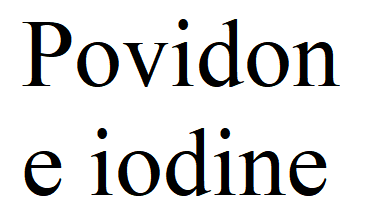Shopping Cart
- Remove All
 Your shopping cart is currently empty
Your shopping cart is currently empty

Povidone iodine (Povidone-iodine) exhibits superior antibacterial properties, effectively targeting both MRSA and MSSA strains with minimum inhibitory concentrations (MICs) of 31.25 mg/L and 7.82 mg/L, respectively.

| Pack Size | Price | Availability | Quantity |
|---|---|---|---|
| 10 g | $29 | In Stock | |
| 1 mL x 10 mM (in DMSO) | $39 | In Stock |
| Description | Povidone iodine (Povidone-iodine) exhibits superior antibacterial properties, effectively targeting both MRSA and MSSA strains with minimum inhibitory concentrations (MICs) of 31.25 mg/L and 7.82 mg/L, respectively. |
| In vitro | Exposure to PVP-I, of which concentrations are even lower than those used clinically, causes toxicity in epithelial cells[2]. |
| In vivo | Povidone iodine is a broad spectrum antiseptic for topical application in the treatment and prevention of infection in wounds. A study investigating its use in defective tissue in neural structures reveals that Myelin changes are absent or minimal in all cases of the control group but are present as markedly increased myelin degeneration in nearly all cases in the PVP-I group. Axonal degeneration and hypoxic neuronal damage are absent in the control group, whereas they are marked in half of the PVP-I group. No statistically significant differences are established in Schwann cell proliferation, venous congestion, and lymphocytic proliferation between the two groups. |
| Kinase Assay | Kinase Inhibition Assay: Kinase inhibition is investigated using one of three assay formats: [33P]phosphoryl transfer, luciferase-coupled chemiluminescence, or AlphaScreen tyrosine kinase technology. IC50s are calculated by nonlinear regression analysis using XLFit.33P -Phosphoryl Transfer Kinase Assay Reactions are performed in 384-well white, clear bottom, high-binding microtiter plates (Greiner, Monroe, NC). Plates are coated with 2 μg/well of protein or peptide substrate in a 50 μL volume of coating buffer contained 40 μg/mL substrate (poly(Glu, Tyr) 4:1, 22.5 mM Na2CO3, 27.5 mM NaHCO3, 50 mM NaCl and 3 mM NaN 3. Coated plates are washed once with 50 μL of assay buffer following overnight incubation at room temperature (RT). Test compounds and enzymes are combined with 33P-γ-ATP (3.3 μCi/nmol) in a total volume of 20 μL. The reaction mixture is incubated at RT for 2 hours and terminated by aspiration. The microtiter plates are subsequently washed 6 times with 0.05% Tween-PBS buffer (PBST). Scintillation fluid (50 μL/well) is added and incorporated 33P is measured by liquid scintillation spectrometry using a MicroBeta scintillation counter.Luciferase-Coupled Chemiluminescence Assay Reactions are conducted in 384-well white, medium binding microtiter plates (Greiner). In a first step enzyme and compound are combined and incubated for 60 minutes; reactions are initiated by addition of ATP and peptide substrate (poly(Glu, Tyr) 4:1) in a final voume of 20 μL, and incubated at RT for 2-4 hours. Following the kinase reaction, a 20 μL aliquot of Kinase Glo (Promega, Madison, WI) is added and luminescence signal is measured using a Victor plate reader. Total ATP consumption is limited to 50%. AlphaScreenTM Tyrosine Kinase Assay Donor beads coated with streptavidin and acceptor beads coated with PY100 anti-phosphotyrosine antibody are used. Biotinylated poly(Glu,Tyr) 4:1 is used as the substrate.Substrate phosphorylation is measured by addition of donor/acceptor beads by luminescence following donor-acceptor bead complex formation. Kinase and test compounds are combined and preincubated for 60 minutes, followed by addition of ATP, and biotinylated poly(Glu, Tyr) in a total volume of 20 μL in 384-well white, medium binding microtiter plates (Greiner). Reaction mixtures are incubated for 1 hour at room temperature. Reactions are quenched by addition of 10 μL of 15-30 μg/mL AlphaScreen bead suspension containing 75 mM Hepes, pH 7.4, 300 mM NaCl, 120 mM EDTA, 0.3% BSA and 0.03% Tween-20. After 2-16 hours incubation at room temperature plates are read using an AlphaQuest reader. |
| Cell Research | One day after seeding, wells are exposed to PVP-I (0.01 to 1000 μM), which has been diluted with DMEM containing 10% FBS. Plates are further cultured for 1 or 2 days at 37℃ in a 5% CO2 incubator. The cell incubation time of 1 or 2 days is determined based on data regarding the onset time of iododerma and nephropathy pathogenesis.(Only for Reference) |
| Alias | PVP-I, PVP iodine, Povidone-iodine, Isodine, iodopovidone, Betadine |
| Cas No. | 25655-41-8 |
| Relative Density. | no data available |
| Storage | Powder: -20°C for 3 years | In solvent: -80°C for 1 year | Shipping with blue ice. |
| Solubility Information | Ethanol: 27 mg/mL, Sonication is recommended. DMSO: 55 mg/mL, Sonication is recommended. H2O: 26 mg/mL, Sonication is recommended. |

Copyright © 2015-2025 TargetMol Chemicals Inc. All Rights Reserved.